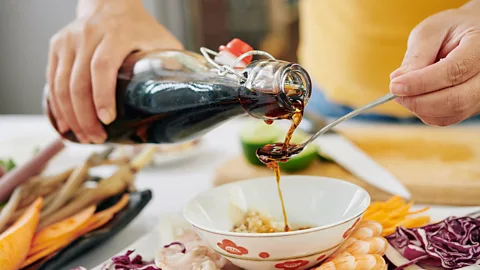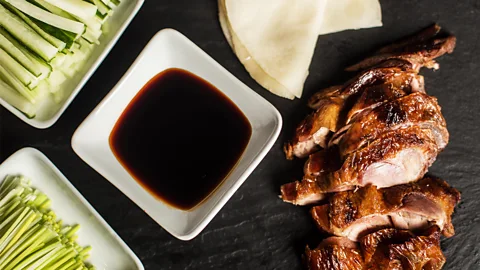From Korea’s doenjang and gochujang to Hong Kong’s XO sauce and East Asia’s fish sauce, Asian cuisines provide hundreds of ways to flavour and season dishes.
Across Asia, myriad sauces add layers of flavour, depth and instant seasoning to dishes, far surpassing any measure of salt and pepper. From Korea’s doenjang and gochujang to Hong Kong’s XO sauce and East Asia’s fish sauce, there are hundreds of different sauces on the market. Many of these have fermentation as a common thread, creating deeply complex flavours that are a result of patience and time. This article will guide you through some of the most common and how to use them.
XO sauce
This elusively named condiment originated in Hong Kong, with roots dating to the 1970s and 80s. “XO”, which stands for “extra-old”, is a nod to XO cognac – an aged liquor that often signifies wealth and prestige in Hong Kong. However, the semblance between the sauce and the cognac ends there, as there’s no actual liquor in XO sauce. “XO” simply provides the connotation of luxury, hinting at the array of expensive ingredients within the jar.
The condiment, which is a staple of Cantonese cuisine, has foggy origins. Hong Kong’s Sun Tung Lok restaurants have laid claim to its invention, though it’s also said that it was first created in 1986 at The Peninsula Hotel’s Spring Moon restaurant.
While there’s no standardised XO recipe, the ingredients typically include dried scallops and shrimp, as well as garlic, red chillies and ginger. Some variations include Chinese dry-cured ham. The resulting sauce is mildly spicy, savoury and smoky. Use it as a condiment with subtly flavoured dishes such as noodles, steamed seafood like scallops and white fish, or on dim sum dishes such as rice rolls and radish cake. XO can also be used as a seasoning to braise meats and flavour vegetables.
 Getty Images
Getty ImagesChinese and Japanese soy sauce
Originating in China about 2,200 years ago, the first known soy sauce recipe was recorded in an ancient Chinese agriculture text, with records showing that some of the first versions of soy sauce were closely linked to jiang, a soybean paste fermented with meat, millet and salt.
There are many varieties of soy sauces used worldwide, including Chinese light and dark soy sauce, Hong Kong sweet soy sauce, Japanese shoyu, Taiwanese soy sauce, Korean ganjang and Indonesian kecap manis. They all consist of the same main ingredients: fermented soybean paste, wheat, yeast and salt.
World’s Table
BBC.com’s World’s Table “smashes the kitchen ceiling” by changing the way the world thinks about food, through the past, present and future.
Chinese soy sauce is brewed in two primary ways: light and dark. Made from the first press of fermented soybeans and aged anywhere from days to months, light soy sauce is thinner and saltier than dark soy and is used in everyday cooking for a pop of flavour. Alternatively, dark soy is made at the end of the pressing process. It is thick, dark and sweet, as it often includes molasses or caramel. It’s used sparingly to add colour and roundness to dishes like stir-fries, braises and marinades.
Japanese soy sauce (shoyu), is typically made with an equal ratio of soybeans and wheat, resulting in a mild, slightly sweet flavour. It has a long brewing time and as such, it’s complex and rich. Tamari, which is often used in place of Japanese soy, is made from miso (fermented soybean paste), but without wheat, making it a rich, gluten-free option that can be used in a variety of dishes.
Sweet chilli sauce
This staple condiment is popular in many cuisines, but it’s perhaps best known in Thailand where it is believed to have originated (there are conflicting stories of its origin). The sauce tastes as the name would describe – sweet and a little spicy. Primarily made of red chillies, rice wine vinegar and a sweetener like sugar or honey, sweet chilli sauce may also have notes of garlic, rice wine vinegar and fish sauce, depending on the producer.
 Getty Images
Getty ImagesCorn starch is usually added to create a slightly thick consistency that makes for a perfect dipping sauce served alongside crunchy, salty and deep-fried dishes such as spring rolls and chicken wings. It also makes a great glaze and adds punchy sweetness to stir-fries.
Oyster sauce
If you’ve been to a Chinese grocery store, chances are you’ve come across the Hong Kong sauce giant, Lee Kum Kee. Legend has it that oyster sauce was invented by Lee Kum Sheung in 1888 when he was boiling a pot of oyster soup and accidentally left it on the stove overnight. The next day, the soup was transformed into a thick, caramelised, gravy-like sauce — aka the oyster sauce we know and love today.
The sauce is rich, umami-filled and savoury with a hint of sweetness that’s perfect for stir-fries, stews and dipping sauces. There are numerous brands on the market and even Lee Kum Kee makes two variations: original and panda oyster sauce. The “original” oyster sauce contains about 40% oyster extract while “panda” only contains 11%. Oysters naturally contain umami, which means the more oyster extract in your chosen sauce, the deeper and richer your food will taste.
Hoisin sauce
Hoisin sauce is a thick, sweet, savoury sauce popular in Cantonese cuisine. The word hoisin is derived from the Cantonese pronunciation of “seafood” – but there’s no actual seafood in the sauce, nor is it typically eaten with seafood. Instead, hoisin sauce is used for vegetable and meat stir-fries or in marinades such as char siu, a Cantonese-style barbecue pork. It’s also often served alongside Peking duck as a dipping sauce, and at Vietnamese restaurants it’s used as a condiment for phó (soup with noodles and meat).
 Alamy
AlamyThe main ingredient in hoisin sauce is fermented soybean paste, combined with thickening agents such as corn starch and sweet potato powder. Other ingredients include sesame paste, sugar, rice vinegar and spices such as red chilli peppers and garlic. While peanut butter is often listed in the ingredients of online recipes, there are no peanuts in traditional hoisin sauce.
Chinese black bean sauce
Fermented black beans (made from soybeans) were discovered in a tomb that was sealed in 165 BCE during China’s Han Dynasty, making them the oldest known soy food. The fermented beans are a key ingredient in all-purpose black bean sauce, which includes soy sauce, garlic, ginger, vinegar and sometimes a sweetener like sugar. It’s salty, pungent and umami-rich and a versatile ingredient/condiment that can be used in stir-fries and marinades. When used alongside aromatics, proteins and other sauces (such as soy sauce), the intense flavour of the black bean gets diluted, leaving a savoury richness that brings an unmistakable level of extra flavour to a dish. There are variations on the sauce (such as black bean garlic sauce and chili black bean sauce) that merge additional flavours into the fermented beans